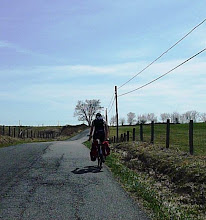I packed the camp site this morning in the rain, not knowing the day I was in for. I was riding through desolate country- cars only passed once every ten minutes- a house went by every several miles. I could not tell whether there was nothing between me and the horizon in each direction or whether the persistent fog was blocking signs of civilization. About 50 miles in, halfway through "Long Thin Dawn" on my ipod, I heard the foreboding shake of thunder from behind. I turned to see an enormous black cloud closing in. Facing forward again, I realized how dark the sky in front of me had become. For the first time today the desolation and realization of "no place to hide" struck me like a wave. Except for the telephone poles, I was the highest object to attract lightening; except for drains under the roads there shelter was few and far between. With this relization came never before discovered motivation. For ten miles I pounded out 20mph on flat windless ground. I reached a town just in time to see the warm system (that has been my tailwind for the past few days) from the east meet the cold front from the southwest. Five minutes after reaching the gas station hail started hailing down and the clouds began to spin right in front of me. The picture tells the rest of the story.
I started to talk to Charlie and Pat Norton who were on there way back home, but taking shelter from the imminent tornado. After some friendly talk about the apocalypse outside and the area, they offered to take me in for the night. Little did I know I was staying with a Kansas celebrity. Charlie and Pat are a bronze artists and sculpted one of the eight wonders of Kansas. The largest bronze piece of Buffalo Bill stands in Oakley and is historically correct in every detail. You can see more of his amazing work at http://www.charlienortonbronze.com/.
I have learned a lot from the Norton's during my brief time with them. On the way home I was told that this area of western Kansas is known for its cattle feedlots. Cows from around the country are brought here to feed for 90-180 days (depending on the desired marbilization or fat of the meat) on the rich regional produce before taking them to slaughter. In the large slaughterhouse here, over 5,000 cattle are processed a day. I also discovered that the large co-op buildings that are everywhere (there was a picture yesterday) are full of last years harvest being cooled and dried by enormous fans. While much of this is sold for food, some is reserved for feedlots and making ethanol.






No comments:
Post a Comment